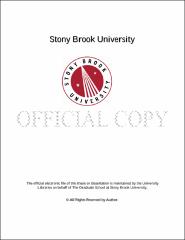| dc.identifier.uri | http://hdl.handle.net/11401/77385 | |
| dc.description.sponsorship | This work is sponsored by the Stony Brook University Graduate School in compliance with the requirements for completion of degree. | en_US |
| dc.format | Monograph | |
| dc.format.medium | Electronic Resource | en_US |
| dc.language.iso | en_US | |
| dc.publisher | The Graduate School, Stony Brook University: Stony Brook, NY. | |
| dc.type | Dissertation | |
| dcterms.abstract | Whereas much of ecological research has been focused on enumerating the differences among ecological communities, it is equally important to understand their similarities. Food webs exhibit remarkably conserved patterns regardless of the type of environment in which they are found. Evolutionary and ecological processes are able to generate a variety of community configurations, but some of these will have a higher chance of being stable. Selection on these configurations based on their stability properties should lead towards an increased representation of stable structures. Moreover this selective process will operate the same across different environmental contexts. The goal of this dissertation is to examine whether commonly observed food web properties may be the result of selection on stability. I have focused on two properties in particular: (1) that food chains tend to be short, and (2) three-species food web motifs. For both of these properties I detected the signature of a selection on stability process. Food webs with short food chains are more likely to be stable. Likewise, the three-species modules that are most likely to be stable (tritriphic chains, apparent and exploitative competition) are also those that occur more frequently than expected by chance in empirical food webs. To better understand how selection on stability may interact with pattern generating mechanisms I used simulated species removals and introductions coupled with a bioenergetic model of species dynamics. Species removals and introductions that alter food web properties towards unstable structures should result in decreased persistence and invasion success respectively. I found some support for this hypothesis, although the manner by which dynamics were modeled had a substantial impact on the results. Nonetheless the framework of selection on stability may be a simple yet powerful tool to aid ecologists in generating an expectation of what should be observed in natural communities. | |
| dcterms.available | 2017-09-20T16:52:36Z | |
| dcterms.contributor | Baines, Stephen | en_US |
| dcterms.contributor | Ginzburg, Lev R | en_US |
| dcterms.contributor | Padilla, Dianna K | en_US |
| dcterms.contributor | Allesina, Stefano. | en_US |
| dcterms.creator | Borrelli, Jonathan Joseph | |
| dcterms.dateAccepted | 2017-09-20T16:52:36Z | |
| dcterms.dateSubmitted | 2017-09-20T16:52:36Z | |
| dcterms.description | Department of Ecology and Evolution | en_US |
| dcterms.extent | 206 pg. | en_US |
| dcterms.format | Application/PDF | en_US |
| dcterms.format | Monograph | |
| dcterms.identifier | http://hdl.handle.net/11401/77385 | |
| dcterms.issued | 2016-12-01 | |
| dcterms.language | en_US | |
| dcterms.provenance | Made available in DSpace on 2017-09-20T16:52:36Z (GMT). No. of bitstreams: 1
Borrelli_grad.sunysb_0771E_12946.pdf: 2876224 bytes, checksum: ff9bb36191964347c8fedb6dfda9eb84 (MD5)
Previous issue date: 1 | en |
| dcterms.publisher | The Graduate School, Stony Brook University: Stony Brook, NY. | |
| dcterms.subject | community dynamics, food web, network, stability | |
| dcterms.subject | Ecology | |
| dcterms.title | Selection on stability in food webs | |
| dcterms.type | Dissertation | |

